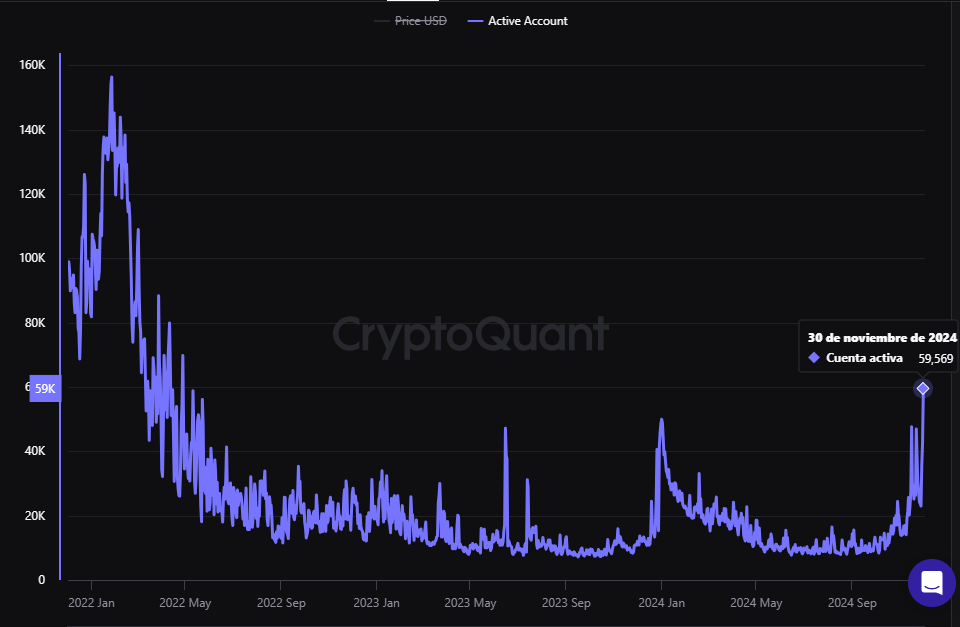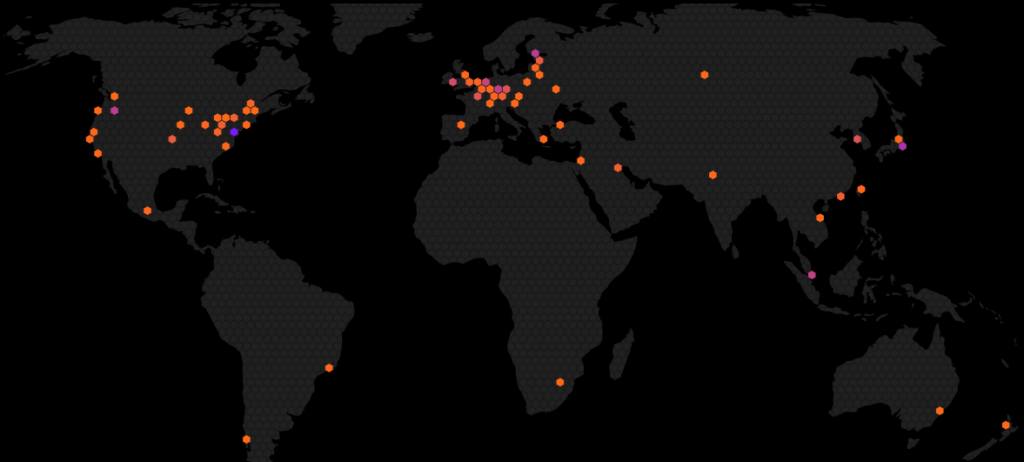The price of XRP, the native Cryptocurrency of the 75 dollars.
This increase positions XRP as the fourth cryptocurrency in biggest price increase in the last 90 days, behind Stellar (XLM), Hedera (HBAR) and Dogecoin (DOGE), according to data from Altcoin-season-index/” target=”_blank” rel=”noreferrer noopener”>Blockchain Center.
Added to this, XRP is already the third largest cryptocurrency in terms of market capitalization, with almost 140 billion dollars, behind Bitcoin/” target=”_blank” rel=”noreferrer noopener”>bitcoin (BTC) and Ethereum-eth/” target=”_blank” rel=”noreferrer noopener”>ether (ETH).
In this way, while XRP market data shoots up and Ripple, the company that created XRPawaits the prompt approval of its RLUSD stablecoin, this article will review what the on-chain activity of the XRP Ledger reflects.
More active addresses and more transactions on the XRPL network
Along with the increase in the price of XRP, the number of active addresses in the XRP Ledger network grew noticeably from the beginning of November 2024.
This metric was, as of November 30, at almost 60,000 active addressesa figure not recorded since the end of April 2022, according to the analysis site CryptoQuant.

Currently, the levels of active addresses on XRPL have reached those of April 2022. Source: CryptoQuant.
More active addresses could translate into more investors and users participating in the XRPL ecosystem.
In this sense, the Santiment platform highlighted today, December 2, 2024, that in the last 3 weeks wallets containing between 1 million and 10 million XRP accumulated 679 million XRP (valued at around $1.6 billion).
That the network acquires a greater number of active accounts and sees the volume of XRP holdings increase implies a key boost in market confidence to attract more investors.
In addition, the number of daily transactions also increased drastically from the last days of October to the present.
For example, on October 26, XRPL only processed just over 54,000 transactions, while on December 2, 2024, that statistic surpassed 3,200,000 transactionsaccording to XRPScan.
In 2024 the total value locked in XRPL increased
During 2024, the total value locked (TVL) on the XRPL network has progressively increased.
The most significant increase occurred from April to September approximately, subsequently stabilizing around 14 million XRP, according to data from XRPScan, which is equivalent to more than 37 million dollars at the time of this article.


The TVL on XRPL has grown at a slow but steady pace since August 2024. Source: XRPScan.
Through this image, it can be established that XRPL has shown signs of gradual, although delayed, adoption in recent weeks.
In relation to this data, and in accordance with DeFiLlamaalmost all of that percentage of XRP’s TVL is located on the network’s decentralized exchange (DEX), XRPL DEX.
The TVL in the context of the XRP Ledger refers to the total value locked or deposited in smart contracts or decentralized applications (dApps) that operate on this network.
It represents the value in dollars or another equivalent currency that users have deposited in DeFi protocols, including liquidity pools, loans within the XRP Ledger ecosystem.
DeFi activity on XRPL grows
Another on-chain metric that is showing good signs in recent weeks is the activity of Automated Market Makers (AMM Counts). This is an important statistic for evaluating DeFi activity on a network.
AMM Counts (Automated Market Maker) are protocols that allow asset exchanges in a decentralized way through liquidity pools, without the need for a traditional order book. In the context of the XRP Ledger, they measure the number of active Automated Market Makers on the network.
From the end of October to the present, this measurement has grown and exceeded 9,000 Automated Market Makers, according to XRPScan.


The number of Automated Market Makers grows in XRPL. Fountain: XRPScan.
AMM Counts mechanisms are fundamental in the decentralized finance ecosystem, as they facilitate trading and offer users the possibility of generating passive income by providing Binance.com/es/articles/what-are-liquidity-pools-in-defi” target=”_blank” rel=”noreferrer noopener”>liquidity in the pools.
On the XRP Ledger, the AMMs functionality was enabled in March 2024 with the implementation of the amendment XLS-30which marked a significant step towards the expansion of this network’s DeFi ecosystem.
The expansion of AMMs on XRPL reflects the growing interest in using the network for decentralized activities such as asset exchange and liquidity provision by the users and developers of the XRPL ecosystem.
Some features of XRPL
The XRP Ledger network is a project open source which is governed by its decentralized community. That is, although Ripple created it, It does not exercise governance over it. The initial focus on efficiency for cross-border payments and transfers.
XRPL uses a consensus mechanism called Ripple Protocol Consensus Algorithm (RPCA). Unlike mechanisms such as Proof of Work (PoW) or Proof of Stake (PoS)the RPCA does not depend on Mining or stakingbut of a globally distributed validator node system. Currently, the network has 619 nodes.


XRPL currently has 619 nodes spread across the planet. Fountain: XRP Org.
He RPCA It operates through rounds of consensus between validator nodes spread around the world. Of the total nodes, 111 are active validators responsible for verifying transactions and ensuring the integrity of the ledger.
These validators work independently and decentralized, operated by entities such as companies, universities, organizations and individuals.
The consensus process begins when the nodes collect transactions submitted by users. These transactions go through an initial verification to ensure that they comply with the rules of the protocol, such as authenticity of signatures and adequacy of funds.
Validator nodes then share their valid transaction proposals with others in the network. For a transaction to be included in the ledger, it must receive the support of at least 80% of validators in a unique list called Unique Node List (UNL), which groups the nodes considered trustworthy.
This process is repeated every 3 or 5 seconds, which allows a new block to be processed in that period that averages from 100 to more 200 transactions each.
The fees that users pay for each transaction are 0.00001 XRP, which is equivalent to 0.000027 dollarsa low figure, although it may rise percentage wise the same as the market value of XRP.
On the other hand, validator nodes not only verify transactions, but also play a key role in the decentralization of the network, which is essential for its security and reliability.
XRPL supports EVM compatible sidechains
XRPL stands out for its ability to integrate sidechains compatible with the Ethereum Virtual Machine (EVM). These sidechains are independent networks that operate autonomously, with their own consensus rules, features and applications.
However, they are connected to the main network through an interoperability mechanism known as a bridge, which allows the fluid exchange of assets and data between both networks.
In the case of XRPL, these sidechains give developers the ability to run smart contracts designed for Ethereum within a parallel environment. This opens the doors for integrate dApps and protocols DeFi to the XRPL ecosystem.
Thus, while Ripple prepares the possible arrival of your stablecointhe price of XRP and the on-chain metrics of XRPL reflect a rise in its activity.
Although this data reflects an ecosystem in which its adoption has increased in recent weeks, it will be key to evaluate how the development of these tools continues, such as the evolution of the RLUSD stablecoin, and if users finally adopt these innovations within the ecosystem.
Crypto Keynote USA
For the Latest Crypto News, Follow ©KeynoteUSA on Twitter Or Google News.







